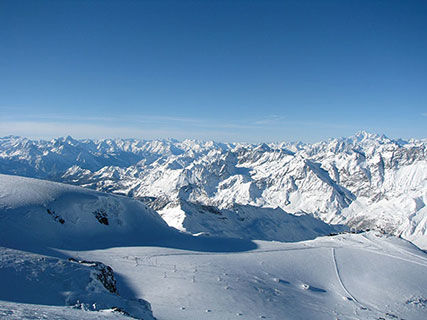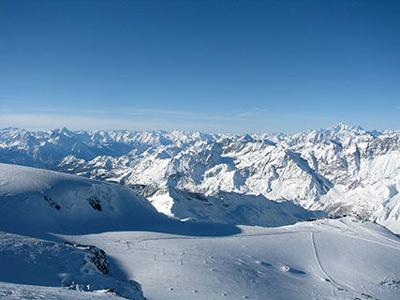Matterhorn: Part of the Swiss Alps in Zermatt Switzerland
That’s a tough question to answer. My Swiss wife, Nicole, and I have skied many of the top ski resorts in North America—Whistler in British Columbia, Vail and Aspen in Colorado and Mammoth Mountain here in California—as well as famous ski areas in France and Switzerland such as Val D’Isere, St. Moritz, Davos and Verbier. Choosing one of those as "the best" is as subjective as naming the greatest city on the planet.
But we do know our favorite ski resort, and that’s Zermatt, home of the iconic Matterhorn, the famous jagged peak that straddles the Swiss and Italian border.
When we talk to friends about Zermatt, I try to use an analogy to which they can relate. Since most skiers in San Diego have skied at Mammoth—where Nicole and I lived for nearly 10 years before moving to Encinitas—I draw on their similarity.

Switzerland's Zermatt
Imagine taking the gondola from Mammoth’s Main Lodge to the top," I’ll say. "It takes around 15 minutes to get there for a vertical rise of 2,000 feet. Now imagine getting to the top of Mammoth and stepping on another gondola for another 15-minute ride. When you arrive, you get on another gondola for another 15-minute ride. And then you get on another gondola for another 15-minute ride. That’s what it’s like getting to the top of Zermatt."
Nicole and I have made more than a half-dozen trips to Zermatt over the years, and we know where we like to go for our first run of the day—down the backside to Italy. After riding a series of gondolas and a final-stage cable car for nearly an hour to the summit of the Klein Matterhorn, we carry our skis 100 yards through a tunnel carved out of the rock. After stepping into our bindings, we push off toward Cervinia, an Italian ski village at the bottom of an Alpine valley.
What follows is an amazing run on wide-open, smooth intermediate terrain that reminds me of skiing the back of Mammoth’s Chair 3 all the way to Main Lodge. The difference is that it takes 45 minutes to reach Cervinia—and longer if you stop to take pictures.
Another thing Nicole and I like to do is stop at a cute restaurant along the way, where we enjoy a plate of pasta or a quattro stagioni pizza on the deck of a rustic mountain chalet. Or course, you’re obliged to pay in Euros since you’re in Italy, although the Italian restaurateurs will accept your Swiss francs or a credit card.
You’re also compelled to watch the time since you want to make sure you get back to the Swiss side of Zermatt before the lifts close. From Cervinia, you have to ride two long gondolas and a cable car—which take another 45 minutes or so—but you can’t miss the last ride of the day at 3 p.m. Otherwise, you’re skiing back to Cervinia and looking for a room for the night.
Skiing on the Swiss side of Zermatt is where the best turns are found. The groomed runs are as wide as the Interstate 5/805 merge. You can really haul at high speeds, since all the bumps have been smoothed over, and there are never any lines on the high-speed chairlifts. Zermatt has 153 miles of trails spanning three mountains—the Klein Matterhorn, Gornergrat and Rothorn—that are generally intermediate, or what Nicole calls "ego skiing." If it’s a bluebird day with a cloudless sky, creamy snow, and the hooked pyramid of the Matterhorn standing majestically over the pistes, I’m not sure how any ski area in the world can eclipse these ski experiences.
At the end of the ski day, you ski a curvy eight-mile trail back to the village, which takes a good half-hour. I’ve found this trail to be the most challenging run of the day because of several steep sections and hard-pack snow that is usually icy. As you near the village, you ski past old wooden farmhouses with slate roofs until you reach the charming gingerbread hamlet of Zermatt, which is car-free and serviced by free electric buses and horse-drawn carriages.
The bustling après-ski and thousands of tourists roaming the paved streets give the Alpine resort a vibrancy that surpasses Vail, Aspen or Whistler. Whether you’re staying at a five-star hotel like the Zermatterhof or a cozy and comfortable bed-and-breakfast, Zermatt offers a ski experience that is, well, on top of this world.





(0) comments
We welcome your comments
Log In
Post a comment as Guest
Keep it Clean. Please avoid obscene, vulgar, lewd, racist or sexually-oriented language.
PLEASE TURN OFF YOUR CAPS LOCK.
Don't Threaten. Threats of harming another person will not be tolerated.
Be Truthful. Don't knowingly lie about anyone or anything.
Be Nice. No racism, sexism or any sort of -ism that is degrading to another person.
Be Proactive. Use the 'Report' link on each comment to let us know of abusive posts.
Share with Us. We'd love to hear eyewitness accounts, the history behind an article.